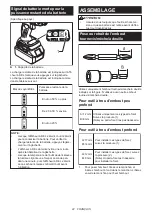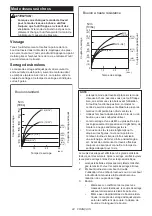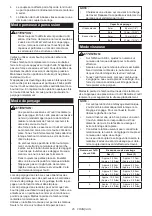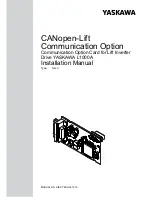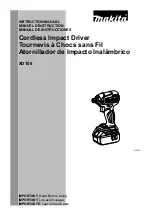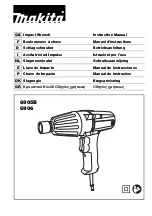
12 ENGLISH
4.
The manner of holding the tool or the material
of driving position to be fastened will affect the
torque.
5.
Operating the tool at low speed will cause a reduc-
tion in the fastening torque.
Hammer drill mode
CAUTION:
•
Always hold the tool firmly during operation.
There is a tremendous and sudden twisting
force exerted on the tool/bit at the time of hole
break-through, when the hole becomes clogged
with chips and particles, or when striking rein-
forcing rods embedded in the concrete.
Be sure to use a tungsten-carbide tipped bit.
Position the bit at the desired location for the hole, then
pull the switch trigger. Do not force the tool. Light pres-
sure gives best results. Keep the tool in position and
prevent it from slipping away from the hole.
Do not apply more pressure when the hole becomes
clogged with chips or particles. Instead, run the tool at
an idle, then remove the bit partially from the hole. By
repeating this several times, the hole will be cleaned out
and normal drilling may be resumed.
Drilling mode
CAUTION:
•
Pressing excessively on the tool will not speed
up the drilling. In fact, this excessive pressure
will only serve to damage the tip of your bit,
decrease the tool performance and shorten the
service life of the tool.
•
There is a tremendous force exerted on the tool/
bit at the time of hole break through. Hold the
tool firmly and exert care when the bit begins to
break through the workpiece.
•
A stuck bit can be removed simply by setting
the reversing switch to reverse rotation in order
to back out. However, the tool may back out
abruptly if you do not hold it firmly.
•
Always secure small workpieces in a vise or
similar hold-down device.
•
Do not pull the switch trigger repeatedly when
the motor is locked. It may damage the tool.
For drilling in wood, the best results are obtained with
wood drills equipped with a guide screw. The guide
screw makes drilling easier by pulling the bit into the
workpiece.
For drilling in metal, to prevent the bit from slipping
when starting a hole, make an indentation with a cen-
ter-punch and hammer at the point to be drilled. Place
the point of the bit in the indentation and start drilling.
Use a cutting lubricant when drilling metals. The excep-
tions are iron and brass which should be drilled dry.
NOTE:
•
Choose suitable speed for the work load. Drilling
over the following capacity may damage the
tool.
–
Drilling capacity
High speed
Steel
6.5 mm (1/4")
Wood
12 mm (15/32")
Low speed
Steel
10 mm (3/8")
Wood
21 mm (13/16")
Screwdriver mode
CAUTION:
•
Adjust the number on the LED display to the
proper torque level for your work.
•
Make sure that the driver bit is inserted straight
in the screw head, or the screw and/or bit may
be damaged.
•
Hold the tool firmly. When the clutch cuts in or
refastening, a sudden twisting force may occur
and it can twist your wrist.
Place the point of the driver bit in the screw head and
apply pressure to the tool. Start the tool slowly and then
increase the speed gradually.
NOTE:
•
This tool employs an electronic clutch. The tool
stops automatically when the clutch cuts in. To
keep operating, release the switch trigger once.
•
When driving wood screw, pre-drill a pilot hole
2/3 the diameter of the screw. It makes driving
easier and prevents splitting of the workpiece.
•
See the following chart for the relation between
the number of torque setting and fastening
torque rate.
The fastening torque rate will be different
depends on materials. Make a test fastening to
get the desired torque before operation.
Number on LED
Display
Fastening torque rate
Low (1)
High (2)
1
Approx. 2.5 N•m
(Approx. 1.8 ft•lbs)
Approx. 1.1 N•m
(Approx. 0.8 ft•lbs)
3
Approx. 4.6 N•m
(Approx. 3.3 ft•lbs)
Approx. 2.0 N•m
(Approx. 1.4 ft•lbs)
5
Approx. 8.1 N•m
(Approx. 5.9 ft•lbs)
Approx. 3.0 N•m
(Approx. 2.2 ft•lbs)
7
Approx. 10.0 N•m
(Approx. 7.3 ft•lbs)
Approx. 4.0 N•m
(Approx. 2.9 ft•lbs)
9
Approx. 11.5 N•m
(Approx. 8.4 ft•lbs)
Approx. 5.8 N•m
(Approx. 4.2 ft•lbs)






















